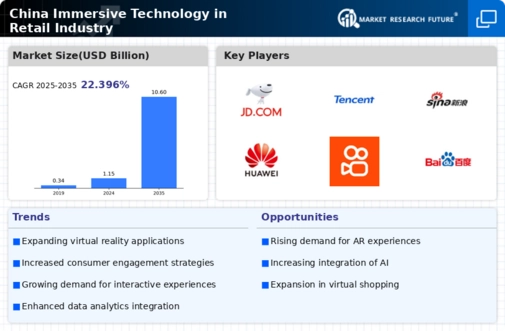Changing Consumer Preferences
Consumer behavior in China is shifting towards a preference for unique and engaging shopping experiences, which significantly impacts the immersive technology-in-retail-industry market. As consumers increasingly seek out personalized interactions, retailers are adopting immersive technologies to meet these expectations. A survey conducted in 2025 revealed that 60% of Chinese consumers prefer shopping environments that incorporate immersive elements, such as interactive displays and virtual fitting rooms. This shift in consumer preferences is prompting retailers to invest in immersive technologies, thereby driving growth in the market. The ability to provide memorable and engaging experiences is becoming essential for retailers aiming to attract and retain customers.
Competitive Pressure Among Retailers
The competitive landscape in China's retail sector is intensifying, driving the adoption of immersive technologies. Retailers are increasingly aware that to differentiate themselves, they must offer unique shopping experiences that captivate consumers. This competitive pressure is pushing many retailers to explore immersive technology solutions, such as VR showrooms and AR product demonstrations. A 2025 analysis indicates that 70% of leading retailers in China are implementing immersive technologies to gain a competitive edge. As competition escalates, the immersive technology-in-retail-industry market is likely to see accelerated growth, as retailers strive to innovate and attract customers in a crowded marketplace.
Technological Advancements in Retail
The rapid evolution of technology in China is a primary driver for the immersive technology-in-retail-industry market. Innovations such as augmented reality (AR) and virtual reality (VR) are becoming increasingly accessible, allowing retailers to create engaging shopping experiences. For instance, the integration of AR in mobile applications enables customers to visualize products in their own environment before making a purchase. This trend is supported by a 2025 report indicating that 45% of retailers in China are investing in immersive technologies to enhance customer interaction. As technology continues to advance, the The immersive technology-in-retail-industry market is likely to expand. This growth is driven by the demand for more interactive and engaging shopping experiences..
Increased Investment in Retail Technology
Investment in retail technology is surging in China, serving as a crucial driver for the immersive technology-in-retail-industry market. Retailers are allocating substantial budgets to adopt advanced technologies that enhance customer experiences. In 2025, it was reported that the retail technology sector in China is expected to reach $200 billion, with a significant portion directed towards immersive technologies. This influx of capital allows retailers to experiment with AR and VR solutions, creating innovative shopping experiences that resonate with tech-savvy consumers. As investment continues to grow, the immersive technology-in-retail-industry market is poised for substantial expansion, reflecting the increasing importance of technology in retail.
Government Support for Technological Innovation
The Chinese government is actively promoting technological innovation, which serves as a significant driver for the immersive technology-in-retail-industry market. Initiatives aimed at fostering digital transformation in retail are encouraging businesses to adopt advanced technologies. In 2025, government policies are expected to allocate over $10 billion towards supporting the integration of immersive technologies in various sectors, including retail. This support not only facilitates the development of new technologies but also encourages retailers to invest in immersive solutions. As government backing continues, the immersive technology-in-retail-industry market is likely to benefit from increased adoption and innovation, further enhancing the retail landscape.

















Leave a Comment